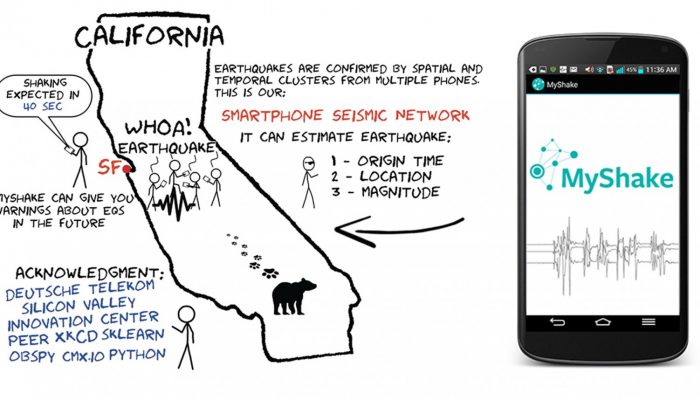
Are you on Facebook or Twitter? Do you use Whatsapp regularly to communicate with friends and loved ones scattered across the globe or even just across the city? I’d be surprised if you answer ‘no’ to all of these questions. In fact, why not admit that you are just as addicted to that smartphone of yours as I am to mine? Being a seismologist, you might have played with one of the various ‘seismometer’ apps, placing your phone flat on its back and watching the accelerometer reading jump into cute little jiggles as you tapped on the table beside it.
These apps seemed of little more than educational use, but this could drastically change thanks to several research groups in California. MyShake, developed by Qingkai Kong and colleagues at Seismolab of UC Berkeley, is available from Google play for Android phones since February. This app has the ambitious aim of turning all those accelerometers riding our pockets into a very densely instrumented Early Warning network. The app functions as data collector: once it is installed, your phone will report event triggerings and even event waveforms to a datacenter that evaluates the recordings from a crowd of phones concertedly. Seismology goes big data.
The perks you can imagine: While few areas of the world have densely instrumented seismic networks that broadcast data in real time, smartphones are present almost anywhere and their numbers are on the rise. Thus, the hope of the developers of MyShake is to complement existing networks with more data, but also to bring Earthquake Early warning to many more regions of the world.
In the future, existing EEW systems that use traditional seismic and geodetic networks could benefit from MyShake just as MyShake could benefit from integration of data from traditional networks. […] Finally, and perhaps most importantly, MyShake could deliver alerts in regions that have little in the way of traditional seismic networks. [1]
Of course, phone accelerometers are cheaper and lower quality than those used in seismic stations, meaning that they have a much higher noise level. Also, you may be wondering, what if I am out for a walk with my pet kangaroo when the Earthquake happens, with my phone tucked away in its pouch? This is where the capabilities of artificial intelligence, and the power of crowdsourcing come in. An artificial neural network within the MyShake app itself distinguishes a P-Wave from your favorite Samba move and other non-Earthquake signals on the basis of three continuously monitored triggering parameters. Once an event is triggered, the phone communicates these parameters to a data center, where they are evaluated in conjunction with triggers from other phones. If many phones report triggers in a seismic wave-like pattern, the algorithm will continuously update the Earthquake origin and try to infer the magnitude. Otherwise, your phone’s report will be quietly filed as “Ah, that guy with the marsupial again.” (Just kidding.)
What challenges are there? One is power consumption: As you can imagine, when the MyShake app continuously checks accelerometer readings, this does similar things to your battery as you continuously checking your twitter feed. The developers are working on this topic and assure on their website that power consumption should not drain your battery extraordinarily fast. What that means remains a little bit hazy.
Another issue is coupling versus sliding: In shaking-table experiments, smartphones lying on the tabletop started sliding at higher accelerations and frequencies, causing a magnitude saturation of the measurements. This is where the smartphone network could tremendously benefit from added information by ‘real’ seismic stations.
Are there privacy issues? I was wondering as I read about MyShake. After all, given an accelerometer taped to your body for large parts of the day, one may easily derive whether you are likely sleeping, running for a bus, or putting on those Samba moves (This has been quite successfully tried on rodents, although they weren’t caught dancing Samba). However, MyShake reports only when triggered. Thus, waveform data should only be transmitted for very short amounts of time, during which you should presumably have paused any activity to wonder whether to take to the nearest door frame.
What the project will benefit from is contributing smartphone users. After receiving widespread media coverage when released (e.g., BBC reported) 170,000 users have already downloaded MyShake to their phones. One especially exciting moment for the MyShake project must have been when a smartphone-seismic record section was produced from the Borrego Springs Earthquake.
This, I must admit, was also what caught my attention for the MyShake app: When I first saw that record section plot appear, guess where … on twitter.
Interested in becoming a crowdsource seismic station? If you want to help improve MyShake, this is your chance of doing so by installing the App if you own an android device. It is a small investment as your phone will have to be charged a little bit more frequently, but it might turn out to be a truly valuable contribution to Early Warning. Think about it!
Interested in other Crowdsourced Earthquake Detection Networks? The seismologists of the world want to turn you into an earthquake detector [2].
References
[1] Kong, Q., Allen, R. M., Schreier, L., & Kwon, Y. W. (2016). MyShake: A smartphone seismic network for earthquake early warning and beyond. Science advances, 2(2), e1501055.
[2] Deatrick, E. (2016), Crowdsourced seismology, Eos, 97, doi:10.1029/2016EO051335. Published on 26 April 2016.
